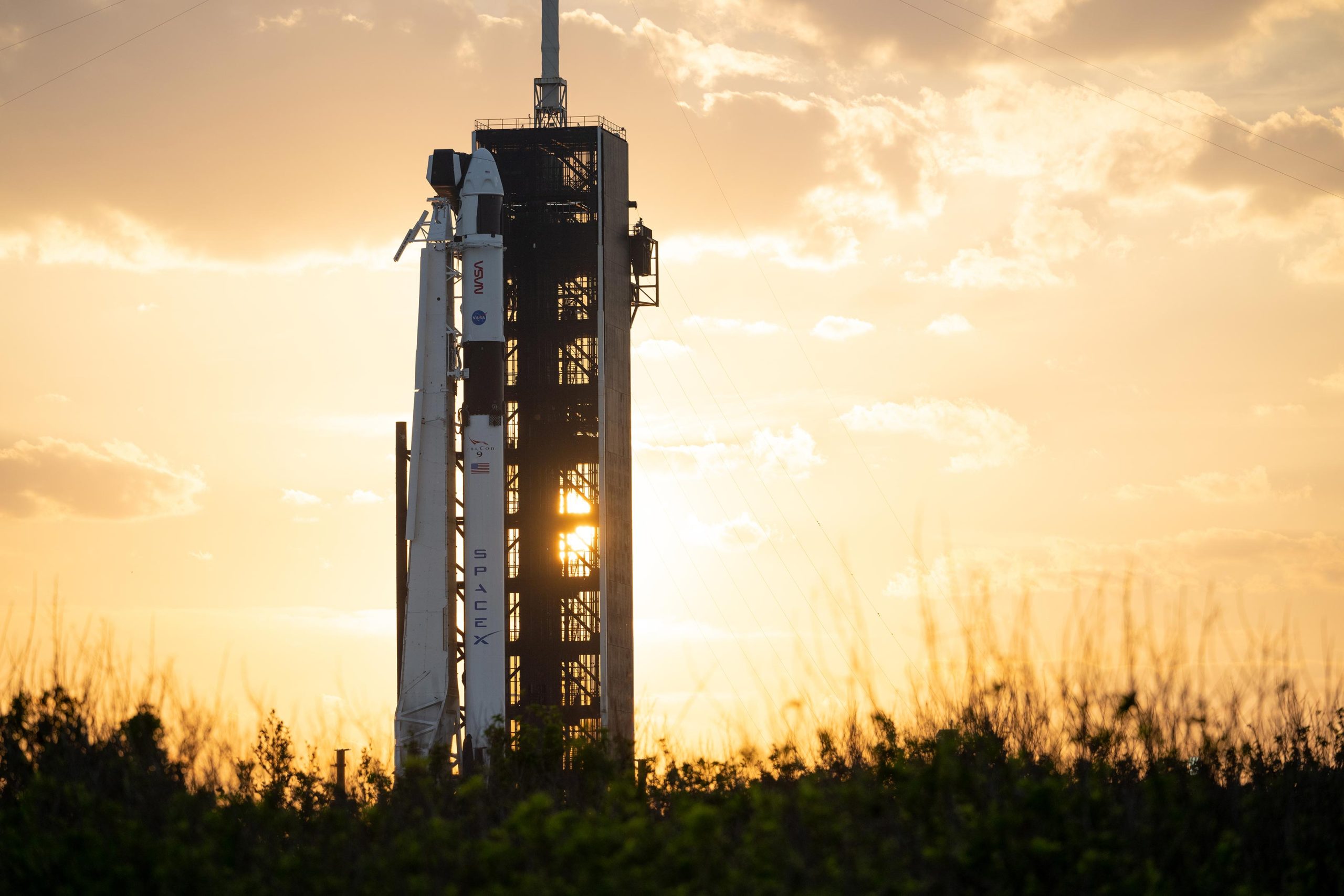Un cohete SpaceX Falcon 9 con la nave espacial Dragon de la compañía se ve al atardecer el sábado 25 de febrero de 2023 en el Centro Espacial Kennedy de la NASA en Florida. El misil está listo en la plataforma de lanzamiento en el Complejo de lanzamiento 39A mientras continúan los preparativos para la misión Crew-6. La misión SpaceX Crew-6 de la NASA es la sexta misión tripulada de la nave espacial SpaceX Crew Dragon y el cohete Falcon 9 a la Estación Espacial Internacional como parte del Programa de Tripulación Comercial de la agencia. Los astronautas de la NASA Stephen Bowen y Warren «Woody» Hoburg, el astronauta emiratí (EAU) Sultan Al Neyadi y el astronauta de Roscosmos Andrei Fedyaev están programados para el lanzamiento a las 12:34 a. m. ET del jueves 2 de marzo desde el Complejo de Lanzamiento 39A en el Centro Espacial Kennedy. Crédito: NASA/Joel Koski
La misión SpaceX Crew-6 de la NASA es «Ir» para el lanzamiento a la Estación Espacial Internacional (ISS) después de completar una revisión de preparación para el lanzamiento, información meteorológica y reunión de gestión de la misión hoy (28 de febrero). lanzamiento en[{» attribute=»»>SpaceX Falcon 9 rocket and Dragon spacecraft from Launch Complex 39A from NASA’s Kennedy Space Center in Florida is now targeted at 12:34 a.m. EST on Thursday, March 2.
Mission teams stood down from a February 27 launch attempt to review an unusual data signature related to confirming a proper bleed in of pad supplied fluid known as triethylaluminum triethylboron (TEA-TEB). TEA-TEB is an ignition fluid used to start the Falcon 9’s nine first stage kerosene/liquid oxygen Merlin engines. The bleed-in process ensures there is an adequate supply of this fluid at each engine to mix with liquid oxygen to start the engines. During prelaunch, the TEA-TEB fluid – which originates in a ground supply tank – flows to the rocket’s interface and back to a catch tank to remove gas from the ground plumbing. During engine start, the fluid then flows to the engines for ignition. Flow into the catch tank is one of several parameters used to determine that the fluid has been properly bled into the system.
After a thorough review of the data and ground system, NASA and SpaceX determined there was a reduced flow back to the ground TEA-TEB catch tank due to a clogged ground filter. This clogged filter fully-explained the signature observed on the launch attempt. SpaceX teams replaced the filter, purged the TEA-TEB line with nitrogen, and verified the lines are clean and ready for launch.

NASA’s SpaceX Crew-6 astronauts walk out of the Neil Armstrong Operations and Checkout Building at the agency’s Kennedy Space Center in Florida on February 26, 2023. In front, from left are NASA astronaut Warren “Woody” Hoburg, pilot; and NASA astronaut Stephen Bowen, spacecraft commander. Behind them, from left are Andrei Fedyaev, Roscosmos cosmonaut and mission specialist; and Sultan Alneyadi, UAE (United Arab Emirates) astronaut and mission specialist. Credit: NASA/Kim Shiflett
Weather officials with Cape Canaveral Space Force Station’s 45th Weather Squadron continue to predict a 95% chance of favorable weather conditions for Crew-6 launch, with the flight through precipitation rule serving as the primary weather concern. Conditions along the Dragon ascent corridor are within acceptable limits, but will remain a watch item for Thursday’s attempt.
NASA astronauts Stephen Bowen, mission commander, and Warren Hoburg, pilot, along with UAE (United Arab Emirates) astronaut Sultan Alneyadi and Roscosmos cosmonaut Andrey Fedyaev, who join as mission specialists, will travel to the space station for a science expedition mission. The international crew will fly aboard the Dragon spacecraft named Endeavour, which previously flew NASA’s SpaceX Demo-2, NASA’s SpaceX Crew-2, and Axiom Mission 1 astronauts.
After an approximate 24.5-hour transit, the crew will dock to the space-facing port of the microgravity laboratory’s Harmony module at about 1:17 a.m. on Friday, March 3. Hatch opening is targeted for approximately 3:27 a.m., followed by the welcome ceremony at about 3:40 a.m. Arrival coverage on NASA TV and the agency’s website begins on Thursday, March 2, at 11:30 p.m.
Starting at 9 p.m. Wednesday, March 1, tune in to a Crew-6 live launch broadcast on NASA TV or the agency’s website and follow along through countdown and other key mission milestones.

«Solucionador de problemas. Gurú de los zombis. Entusiasta de Internet. Defensor de los viajes sin disculpas. Organizador. Lector. Aficionado al alcohol».

